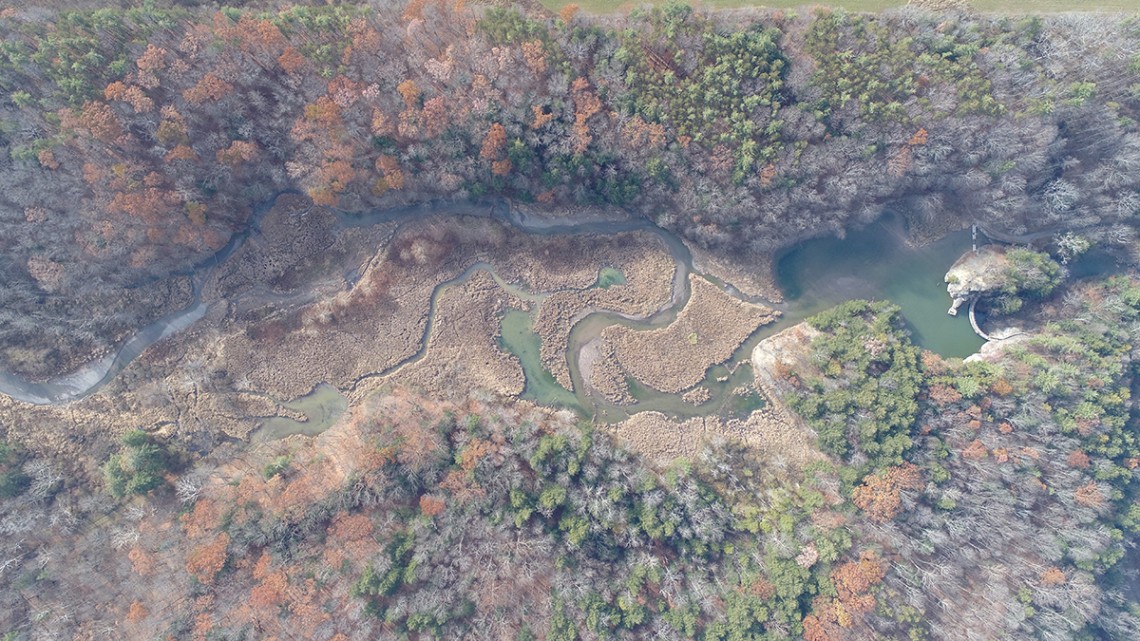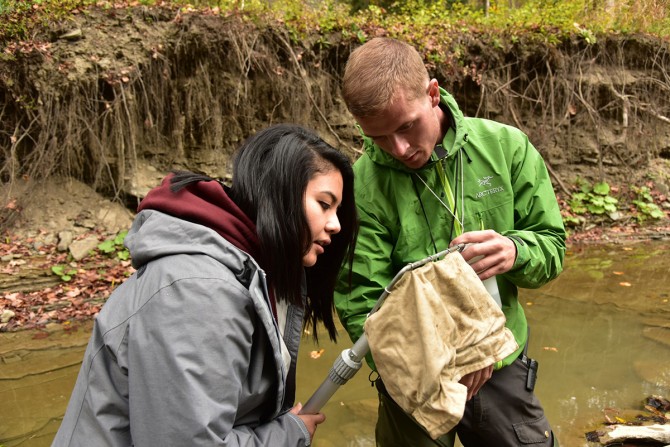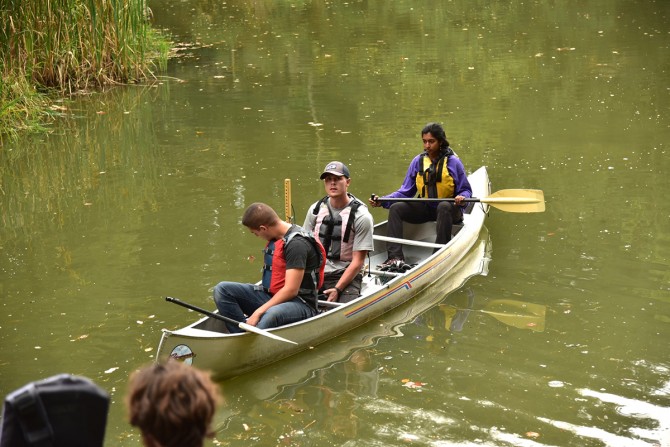
Most of Lake Treman is filled in with sediment and marsh, as the northern end near the dam – as seen on the right – remains navigable.
Restoration ecology class surveys Lake Treman
By Blaine Friedlander
Far above Buttermilk Falls in Ithaca sits a reservoir dam impounding Lake Treman. Hiking trails wend through the area, which for eight decades has slowly accumulated enough sediment to turn the lake into plodding marsh. Sometime in the next 30 years, it will completely fill and become a riparian marsh.
Cornell students in Tom Whitlow’s Restoration Ecology class spent the fall semester examining Lake Treman’s many components, and they worked with the New York State Department of Parks and Recreation to develop a plan for managing it.
The students presented their research to state parks officials in December. Generally, the class found no compelling reason to remove the dam, in spite of the increasing sediment, said Audrey Stanton ’19, a teaching assistant for the course.
“New York state is trying to protect an area the best it can, but without understanding the natural processes going on, they can’t deliver solutions,” said Samantha Schultz ’18. “They asked us to analyze Lake Treman, and we saw a whole mix of things.”
“We looked at a bunch of nature’s different services the area provided,” said Tanvi Naidu ’17, M.Eng.’18, who collected samples of sediment and analyzed the marsh’s methane levels (they are low). “We evaluated it as a wetland and as a lake, and we tried to make predictions. It is definitely not stable in the physical or biological sense.”
With regard to humans, animals, hydrology, disaster management, informing the current situation and determine a future, Naidu said there were many competing preferences.
“You’re astounded at how many different priorities you see when you’re looking at a seemingly simple landscape – and how many of those priorities can be in conflict. I expected the answer to be less complex than it was actually. It’s complicated,” said Naidu.
The students examined biology along trails, inventoried trees and plants, collected water samples and produced a bottom profile of the remaining lake using a canoe equipped with a sonar bathymetry (water depth) system, identified invertebrates and invasive species, collected bacterial samples, and compared the area’s aerial maps over an 80-year period.
When the Civilian Conservation Corps built Lake Treman in 1930, tributaries flowed into the lake from surrounding farmland. But by 1964, the southern end was becoming noticeably marshy.
The entire southern half of the lake became mostly wetland by 1991 – and in 2016, only the northern tip of the lake held navigable water. In a 1938 aerial photograph, Lake Treman encompassed about 16 acres of water. Now the lake has been reduced to 1.9 acres, while the marsh now measures 10.9 acres, according to the students’ calculations.
“The field of restoration ecology is relatively young and rapidly evolving. It lacks the coherence of mature disciplines like physics or chemistry,” said Whitlow, associate professor of plant science. At its best, this field applies environmental theory to solve problems, he said.
Beyond the plants, hydrology and natural systems, students learned about real life. “We worked with many people, and we had to blend a lot of information into a cohesive, comprehensive report,” said Schultz. “The class was very good for understanding real-life skills.”
Schultz explained how students found a beaver dam – built from the invasive, exotic plant Japanese knotweed – that blocked a nearby stream. The students discovered broken pieces of knotweed floating downstream with the water serving as a vector where they could re-root in another place. This could become an increasing problem in the downstream reach of Buttermilk Creek, she noted.
“The big idea of the class was to look at restoration projects from a different viewpoint. Everyone wants simple solutions, one recipe, but in reality, as Dr. Whitlow taught us, problems may have different solutions. Answers are very specific for problematic sites,” said Schultz. “One solution doesn’t fit all.”
Media Contact
Get Cornell news delivered right to your inbox.
Subscribe


